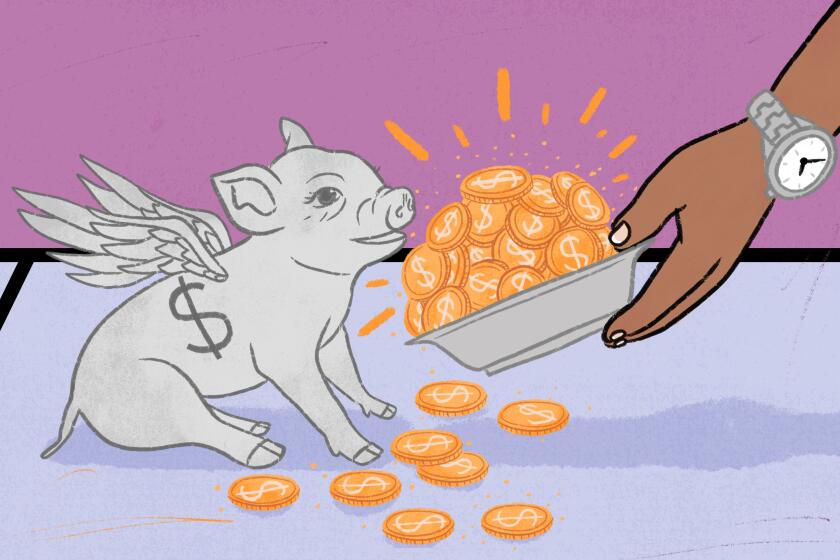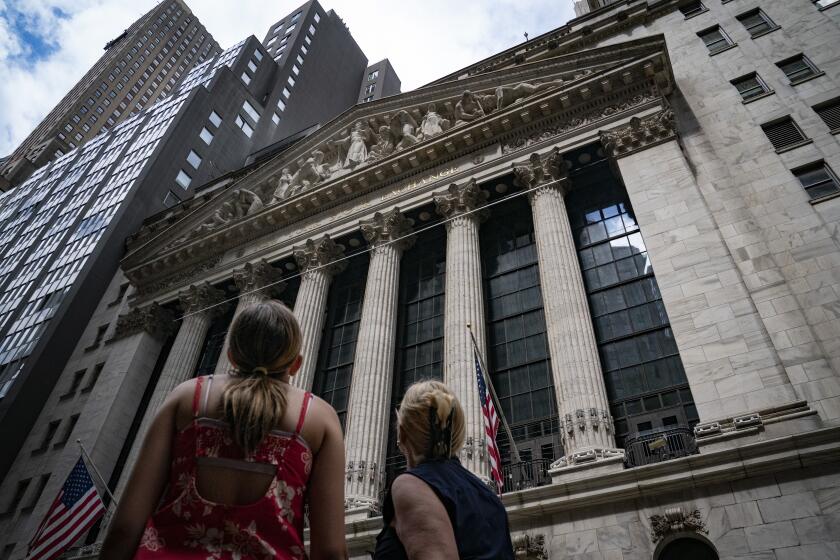Wall Street soars to best day since summer; S&P 500 climbs 2.6%

- Share via
Stocks on Wall Street rallied to their best day in months on Monday after falling bond yields eased some of the pressure that’s been battering markets.
The Standard & Poor’s 500 index’s leap of 2.6% was its biggest since July, the latest swing for a scattershot market that’s been mostly falling this year on worries about a possible global recession. Wall Street’s main measure of health was coming off its worst month since COVID-19 crashed markets in early 2020 and is still down nearly 23% for the year.
The Dow Jones industrial average jumped 2.7% and the Nasdaq composite gained 2.3% in Monday’s widespread rally that swept the vast majority of U.S. stocks higher.
Giving some respite was a drop in Treasury yields, which have been surging at market-shaking speed for most of the year. The yield on the 10-year Treasury, which helps set rates for mortgages and many other kinds of loans, fell to 3.64% from 3.83% late Friday. It got as high as 4% last week after starting the year at just 1.51%.
Helping to drive markets was a report on U.S. manufacturing that came in weaker than expected, along with data showing a drop in construction spending. Although that may seem discouraging for the economy, it could mean the Federal Reserve won’t have to be so aggressive about raising interest rates in order to beat down the high inflation damaging households’ finances.
Don’t let the bear market keep you from retiring. But there are a bunch of other financial and emotional factors to consider before taking the leap.
By raising rates, the Fed is making it more expensive to buy a house, a car or most anything else purchased on credit. The hope is to slow the economy just enough to starve inflation of the purchases needed to keep prices rising so quickly. But the Fed also risks causing a recession if it goes too far.
The Fed has already pulled its key overnight interest rate to a range of 3% to 3.25%, up from virtually zero as recently as March. Most traders expect it to be more than a full percentage point higher by early next year.
The yield on the two-year Treasury, which more closely tracks expectations for Fed action, fell to 4.11% from 4.27% after the weaker-than-expected reports on the economy.
Besides stocks, lower rates also boost prices on things such as cryptocurrencies and gold, which can suddenly look a bit more attractive when bonds are paying less in income.
Stocks of high-growth companies and particularly risky or expensive investments have been the most affected by changes in rates. Bitcoin rallied Monday with the reprieve in yields, while technology stocks did the heaviest lifting to carry the S&P 500. Apple and Microsoft both rose more than 3%.
Your money isn’t disappearing; it’s being used to buy stocks at a discount. When the market rebounds, those shares will benefit from the growth.
Altogether, the S&P 500 climbed 92.81 points to 3,678.43. The Dow gained 765.38 points to close at 29,490.89, and the Nasdaq rose 239.82 points to 10,815.43.
Still, cross-currents continue to course through markets, and analysts largely expect sharp swings in prices to continue.
Crude oil prices jumped Monday amid speculation that big oil-producing countries could soon announce cuts to production, adding upward pressure on inflation.
That prospect lifted shares of energy-producing companies to big gains. Exxon Mobil leaped 5.3%, and Chevron climbed 5.6%.
Monday’s rally came despite an 8.6% drop for Tesla, one of the most influential stocks on Wall Street because of its massive market value. The maker of electric vehicles delivered fewer vehicles from July through September than investors expected.
More turbulence for markets could arrive Friday, when the latest update on the U.S. job market hits. Along with its reports on inflation, the U.S. government’s jobs report has been one of the most highly anticipated pieces of data on Wall Street each month.
The overall job market may be softening, but employers of truck drivers, fast-food cooks and solar roof installers can’t hire fast enough.
It will be the last jobs report before the Fed makes its next decision on interest rates, scheduled for Nov. 2, and continued strength would give the central bank more reason to keep hiking rates. Traders say the likeliest move is a fourth straight increase of a whopping three-quarters of a percentage point.
For markets to make a meaningful move higher, many investors say they need to see a break in inflation that gets the Fed to ease off its aggressive path.
Investors’ hopes for such a Fed pivot have repeatedly resurfaced this year, only to get shot down by further accelerations in inflation.
But with stresses building in financial markets as central banks around the world hike rates in concert, conditions have gotten “into the danger zone where ‘bad stuff’ happens,” said Michael Wilson, equity strategist at Morgan Stanley.
That could get the Fed to blink at some point. The problem, Wilson said, is that another force weighing on markets could soon come to the forefront: weaker corporate profits.
A suite of challenges, including higher interest rates and the surging value of the U.S. dollar, may be setting things up for “the freight train of the oncoming earnings recession,” he wrote in a report. Companies are getting ready now to report in coming weeks how much they earned during the summer, and analysts have been downgrading their expectations.
More to Read
Inside the business of entertainment
The Wide Shot brings you news, analysis and insights on everything from streaming wars to production — and what it all means for the future.
You may occasionally receive promotional content from the Los Angeles Times.













